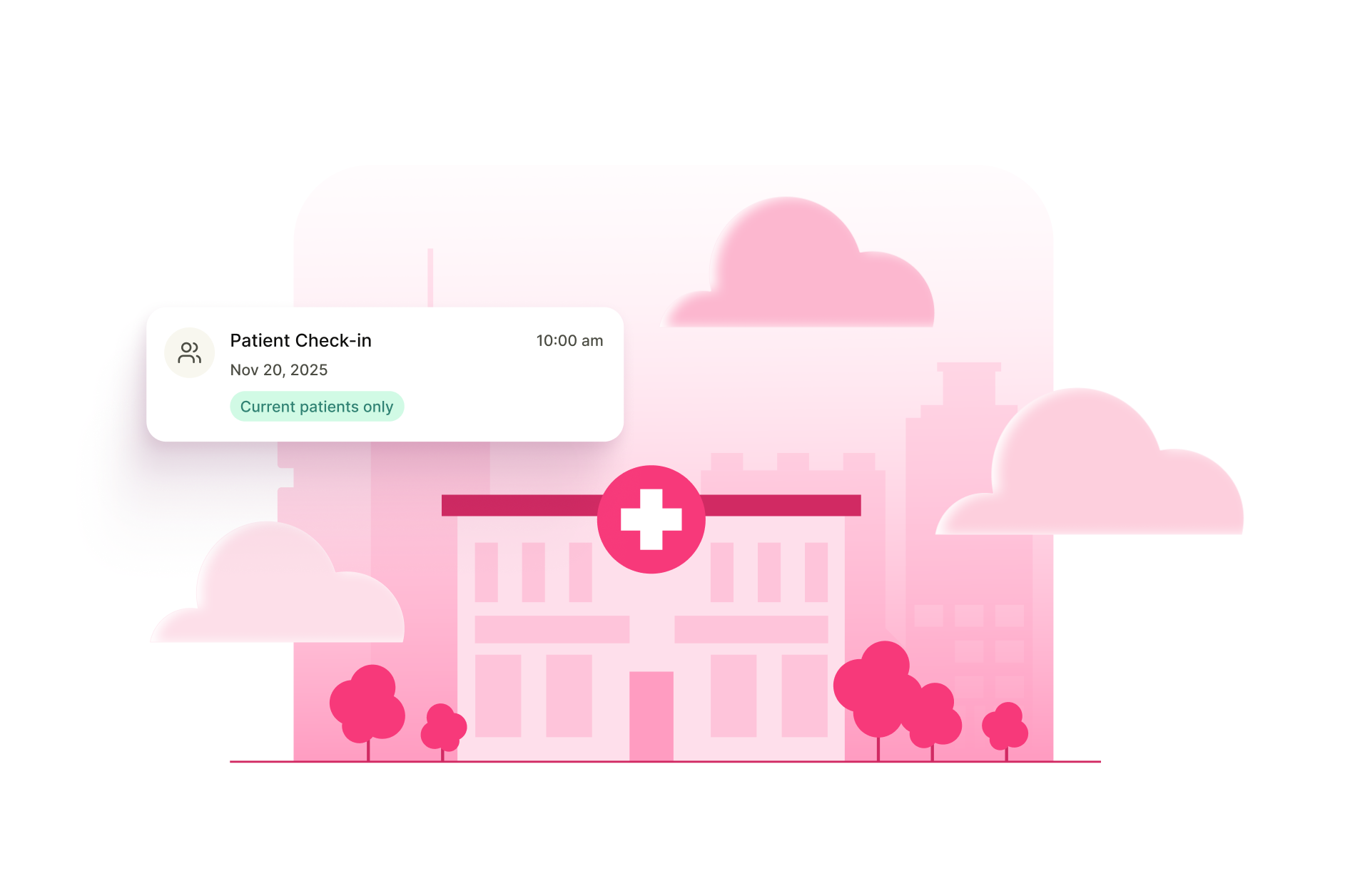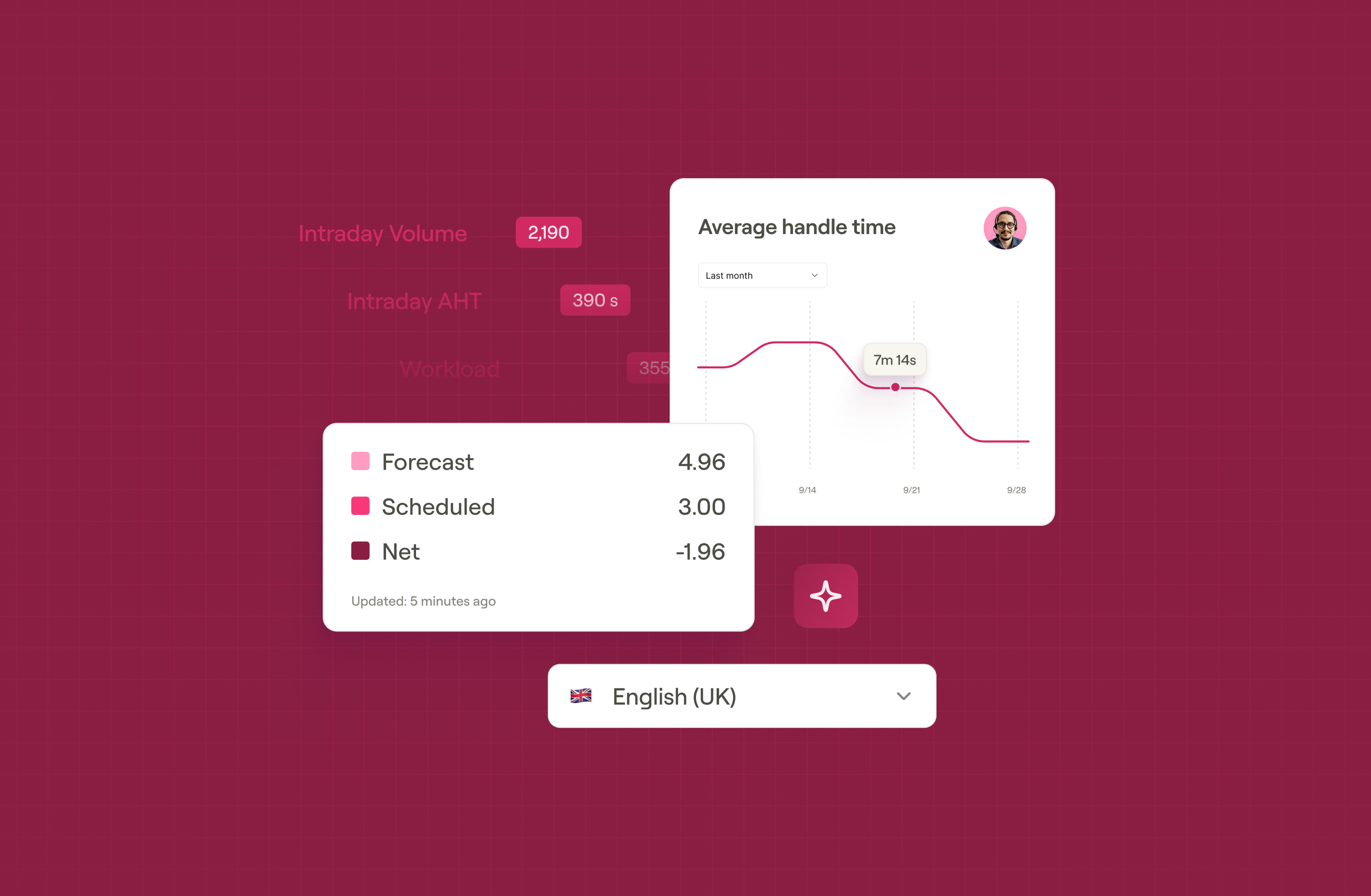Workforce management (WFM) software helps enterprise contact centers forecast demand, build accurate schedules, monitor performance, and keep agents engaged. It plays a critical role in balancing service quality and labor costs while also improving the employee experience.
Finding the right software for your contact center isn't one-size-fits-all—it depends on your specific operational needs. While budget matters, investing in the right solution often pays off.
This article breaks down features, highlights the benefits of WFM software, and provides practical guidance to help you choose the right solution for your contact center.
Read more: Why best-of-breed solutions triumph over single-provider platforms.
Common WFM challenges (and when it’s time to change your software)

Even the best-run contact centers hit walls when their workforce management tools can't handle modern demands.
Basic WFM platforms often fall short in six key areas:
- Outdated tools: Many platforms can’t scale to support today’s complex staffing models or cloud-first environments. They also struggle to integrate modern technologies, slowing down decision-making, limiting visibility, and making it hard to respond to real-time changes quickly.
- Fragmented, siloed systems: Outdated platforms create data silos between workforce management and other systems, forcing managers to work with disconnected information and making it impossible for executives to get a unified view of operations.
- Inaccurate forecasting: Limited forecasting models often result in overstaffing or understaffing. Both scenarios impact service levels, agent productivity, and costs. For example, underestimating seasonal demand could leave you short on agents during peak periods, harming customer experience, while overestimating could mean paying for idle time that drains your budget.
- Inflexible scheduling: Traditional scheduling tools lock managers into static timetables, making it difficult to adapt to fluctuating demand and agent needs. Managers spend too much time adjusting schedules manually, while agents struggle to balance work and life demands.
- Low agent engagement and high turnover: Without features like dynamic scheduling, self-service options, or recognition programs, agents may feel stuck, and turnover rises dramatically, creating costly recruiting cycles and knowledge loss.
- Missing compliance and policy management: Union agreements, labor laws, and industry regulations can be difficult to manage without software built to handle them. Imagine having to manually cross-check every shift against union break rules or track overtime across different regions. Any mistakes could easily lead to legal issues.
Read more: How Aspect ensures union agreements are honored every day.
The cost of sticking with an ineffective WFM solution adds up quickly. Contact centers face higher expenses and missed service targets, but also frustrated employees and dissatisfied customers, while executives lose credibility with leadership teams and boards.
Modern workforce management software addresses these challenges directly. By combining accurate forecasting, dynamic scheduling, employee engagement tools, and built-in compliance support, the right platform turns workforce management from a daily struggle into a competitive advantage.
What’s driving change in contact centers
Today’s contact centers face a mix of persistent challenges and new realities that require stronger workforce management strategies. These include:
- High agent turnover: Retention remains the top challenge for contact center managers. The high attrition drives up hiring costs and disrupts service quality. On the other hand, when agents feel valued and supported, they are more likely to stay.
With modern WFM tools, managers can give agents more control over their schedules and promote fairness through transparent scheduling processes, which can help reduce turnover.
- Remote and hybrid teams: Managing remote and hybrid teams adds new layers of complexity to workforce operations. Without the right visibility, it’s difficult to ensure consistency, adherence, and collaboration across locations.
WFM platforms like Aspect turn this challenge into a chance to support distributed teams without losing oversight, enabling managers to forecast, schedule, and monitor performance seamlessly.
- Rising customer expectations: Customers expect faster, more personalized service across multiple channels, and outdated tools can’t keep up.
Accurate forecasting and smarter scheduling guarantee that the right agents are available at the right time, helping contact centers deliver consistently high service levels.
- Pressure to reduce costs while maintaining performance: Balancing budget pressures with high service expectations is a challenge in contact centers. With automation and data-driven staffing decisions, leaders can optimize staffing levels, reduce labor costs, and maximize efficiency while meeting customers’ demands.
Benefits of workforce management software

The right workforce management solution helps contact centers run more efficiently while improving experiences for both agents and customers.
Here’s what you can expect:
- Improved forecasting accuracy: With better predictions of call volume and staffing needs, managers can match resources to demand more precisely. This prevents long customer wait times and reduces idle agent hours.
- Reduced labor costs: Smart scheduling ensures agents are deployed where they’re needed most. By aligning shifts with actual demand, contact centers can cut unnecessary costs without sacrificing service quality.
- Improved agent engagement and retention: Features like transparent scheduling, mobile access, and recognition programs give agents more control and appreciation, leading to higher job satisfaction and stronger retention.
- Measurable ROI for executives: Managers gain clear visibility into performance improvements, cost reductions, and compliance adherence, making it easier to justify investments and demonstrate value to leadership.
Read more: 6 strategic steps to maximize workforce management ROI.
How to choose the best WFM software: Key features to look for
The best WFM platform depends on your operational needs and future goals. Here are the key features to prioritize when evaluating options:
AI-powered forecasting and intraday management
AI-assisted multi-model forecasting allows managers to predict call volume, chat demand, or email traffic with a high degree of confidence, reducing adherence gaps and last-minute absenteeism issues. For example, a retail contact center heading into the holiday season can use historical data and machine learning algorithms to forecast peak times and schedule additional staff.
Intraday management is just as important. Real-time adjustments allow managers to respond to unexpected spikes by moving agents between channels or calling in backup staff.
Dynamic scheduling tools
Contact centers no longer operate on rigid 9–5 models. A strong WFM platform should provide flexible scheduling tools that balance business needs with employee preferences while promoting fairness and transparency.
Compliance features also matter, whether for ensuring breaks are scheduled according to labor laws or meeting union requirements. By combining flexibility with compliance, managers can balance staffing needs with fairness to agents, which reduces burnout and maintains adherence to regulations.
Performance and quality management
Beyond scheduling, WFM software should help agents perform better. Dashboards that show metrics like average handle times and first-call resolution times give managers clear insights so they can help the team improve performance.
Features like call recording or customer satisfaction surveys pinpoint areas where coaching can improve skills, leading to better service and efficiency.
Gamification and engagement
High turnover is one of the biggest challenges in contact centers, and WFM software with gamification features helps counter it. Leaderboards, achievement badges, and small rewards can all make routine work more engaging.
These features build a sense of progress and recognition, which keeps employees engaged and less likely to leave. In industries where replacing trained agents is costly, engagement directly ties to lower attrition rates.
Integrations and scalability
Choose a unified WFM solution that’s compatible with other tools like CRM systems, contact center platforms, and HR software.
More importantly, look for platforms that unify workforce management data with other data sources rather than creating more silos. This allows for smoother operations, like automatically pulling agent data from HR records or syncing call data for more accurate reporting.
Scalability matters just as much. A large enterprise contact center with hundreds of agents today might grow to thousands within a few years or expand across multiple regions. It might even add new channels and compliance requirements.
Scalable platforms handle growth without system slowdowns or requiring a complete replacement, saving companies both time and money.
Why Aspect is the best solution

Aspect is more than a workforce management tool. It’s a unified AI-powered platform built to handle the unique challenges of enterprise contact centers where complexity is the norm. Here’s how:
Fair and intelligent scheduling
Aspect helps contact center managers build schedules that work for both the business and its employees while maintaining fairness and transparency.
Managers can balance call volumes with time-off requests, overtime limits, and union agreements, while agents get flexibility through mobile access, shift trading, and self-service scheduling.
Fair break coverage and schedule transparency are also essential for supporting employee well-being. Aspect provides automated break planning and real-time updates to keep schedules balanced without constant manual work.
AI-powered forecasting and advanced intraday management
With Aspect, leaders can use forecasting tools that combine advanced AI algorithms with real-time flexibility. The platform uses historical data, external factors, and machine learning to predict demand across all voice and chat channels.
Managers can test what-if scenarios, re-forecast on the fly, and adjust staffing through advanced intraday management. This maintains coverage during peak hours while avoiding unnecessary labor costs.
Unified performance and quality management
Aspect doesn’t just track headcount; it tracks how well agents are performing within a single, unified platform. Clear dashboards highlight KPIs, while coaching and feedback tools help supervisors address performance gaps.
Quality management features strengthen oversight by including call recording, performance scorecards, and compliance protections like PCI-ready storage. Together, these tools eliminate fragmented vendors, lower cost-to-serve, improve customer interactions, and create a cycle of continuous development.
Gamification
Using gamification, Aspect League™ helps managers create competitions, celebrate achievements, reward top performers, and foster a culture of recognition. These features make daily tasks more rewarding, which reduces attrition, improves productivity in high-pressure environments, and increases agent satisfaction.
Real-time visibility and productivity tracking
Aspect gives managers complete visibility into how teams perform with real-time insights that enable immediate action.
Real-time adherence monitoring, shrinkage analysis, and occupancy tracking provide actionable insights to keep operations efficient. Multi-channel performance data is consolidated in one view, giving leaders a stronger foundation for decision-making.
Whether you're searching for a new tool or replacing your current one, download our WFM & WEM Buyers Guide for expert insights on the key criteria for selecting the ideal WFM software.
- How do I know if I need a new WFM solution?
You may need a new workforce management solution if you struggle with:
- Missed SLA targets and unpredictable performance
- Constant firefighting and schedule changes
- High agent turnover and low morale
- Fragmented systems that create data silos
- Limited visibility into real-time performance
- Adapting to union rules and hybrid work models
- What features define the best workforce management software?
The best WFM platforms combine the following features:
- AI-powered forecasting: Predicts call volume and staffing needs with precision so leaders can avoid overstaffing or understaffing.
- Fair and transparent scheduling: Supports multi-skill agents, automates time-tracking, handles hybrid or remote work models, and meets union requirements while maintaining service levels.
- Agent engagement and recognition tools: Keep agents engaged with recognition programs, challenges, and rewards that improve performance and reduce turnover.
- Performance management: Provides visibility into KPIs, coaching opportunities, and quality monitoring so managers can act on data in real time.
- Unified platform integrations: Connects with CRMs, contact center systems, and other tools to reduce silos and improve efficiency.
- What industries benefit most from workforce management tools?
Any industry that runs large or complex contact centers will benefit from specialized workforce management solutions to stay efficient and compliant. This includes financial services, healthcare, retail, utilities, and telecommunications, where staffing accuracy, agent retention, regulatory requirements, and customer experience are all priorities.
- Why choose Aspect over other WFM vendors?
Aspect is a purpose-built WFM platform designed for enterprise contact centers. Its strengths include AI-powered forecasting, dynamic scheduling, and performance insights that help you optimize workforce management.
Aspect also offers agent engagement features and unifies workforce management with performance and quality management, giving leaders a complete view of their operations within a single platform.
Added to this is the Aspect Workforce mobile app, which lets agents control their schedules from anywhere. With mobile access, employees can view shifts, submit requests, swap availability, and receive instant updates without relying on a desktop.









